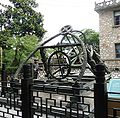Observatory on the purple mountain
The Purple Mountain Observatory ( Chinese 紫金山天文台 , Pinyin Zijinshan Tiānwéntái ), internationally known Purple Mountain Observatory, is an observatory near the city of Nanjing in the People's Republic of China . The observatory is located in the eastern outskirts of the city on a hilltop in the west of the Purple Mountains at an altitude of 267 m above sea level.
Construction of the observatory began in 1929. Five years later, on September 1, 1934, observation operations began. In December 1937 during the Second Sino-Japanese War almost completely destroyed, the few surviving buildings used for housing, as through the transfer of the capital of the KMT regime in 1946 housing became scarce from April. Reconstruction began in September. Today the facility is a modern astronomical observatory, which is subordinate to the Chinese Academy of Sciences .
Three comets were discovered at the observatory on Purple Mountain , including the periodic 60P / Tsuchinshan . The discoveries also include 147 asteroids , including the Trojans (2223) Sarpedon , (2363) Cebriones and (2456) Palamedes , as well as the (3494) Purple Mountain named after the control room .
The observatory has been on the list of monuments of the People's Republic of China since 1996 .
Historical astronomical instruments
Original historical astronomical instruments can be viewed on the site, such as B. an armillary sphere . With this instrument, which was built in 1437, one could determine the equatorial ecliptic and the horizontal coordinates of celestial bodies. The rings are divided into scales of 365.25 and 100. This type of scale system denotes the characteristics of astronomy in ancient China. German troops brought this armillary sphere to Berlin in 1900 when the United Eight States ( Boxer War ) invaded Beijing. The instrument was brought back to China in 1920.
Another historical device is the simplified armillary sphere . With this instrument based on the armillary sphere, both equatorial and horizontal coordinates of celestial bodies could be measured without mutual interference. This instrument was made in 1437 based on an idea by Guo Shou-jing (1231-1316). This instrument was also brought to France as spoils of war in 1900 and returned to China in 1905.
Web links
Individual evidence
- ↑ 中央研究院 天文 研究所 的 建立 与 演变. In: http://www.acas.ac.cn . September 5, 2014, accessed April 8, 2019 (Chinese).
- ↑ Melby, John F .; Mandates of Heaven; London 1969 (Chatto & Windus); US diplomat and temporary resident.
Coordinates: 32 ° 4 ′ 0.9 ″ N , 118 ° 49 ′ 29.9 ″ E



